Welcome to the third in a five-part series about making money from your art at fairs and festivals.
I've sold my work at nearly 100 events across the United States over the past 12 years. It has been a rewarding and lucrative experience. Participating in festivals can help you meet new fans of your work, get feedback directly from buyers, and make money at the same time! I have learned so much from selling my work at events, and am sharing everything here in this big five-part series. If you've ever considered applying for a show, I encourage you to go for it! A five-part series may seem overwhelming, but I'm breaking down EVERYTHING you need to know.
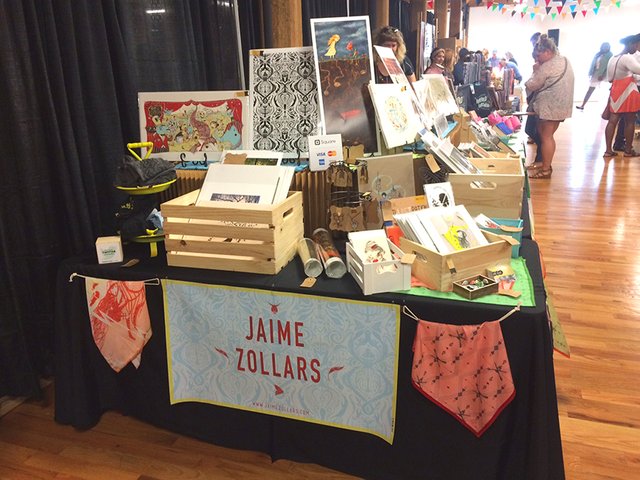
My indoor booth two weeks ago at a show called Indie Craft Parade in Greenville, SC
Part One: Finding Shows and Getting In (link to previous post)
Part Two: Preparing Your Work (link to previous post)
Part Three: Preparing Your Display
Part Four: Getting Sales
Part Five: After the Show
Part Three: Preparing your booth
In parts one and two of this series, we applied to an art festival, and prepared our work for sale. The hardest part of this process is now complete!
Alas, so many sellers stop here, and consider their booth display secondary. But the way that you present your work can have a huge effect on how many buy it, as well as how much those people are willing to pay. Paying attention to the long view of building an audience and a brand will make your shows much more profitable. In this third installment, we’ll talk about booth logistics, options and tips to get the most out of your display.
Booth Basics
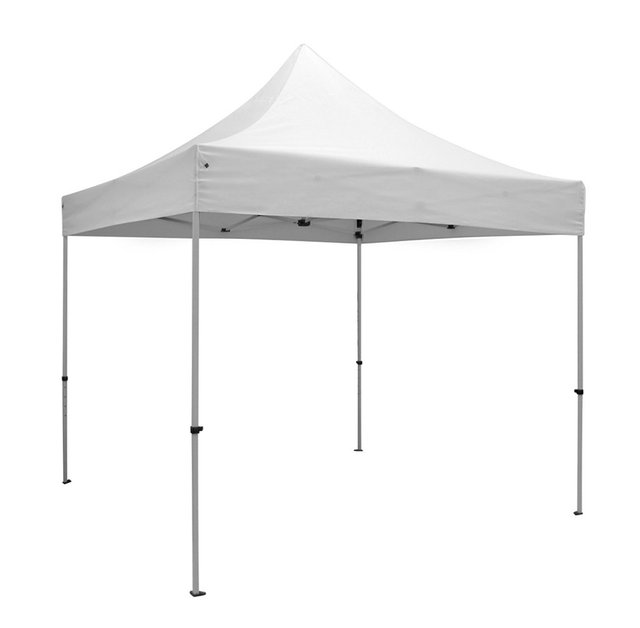
Tent / Canopy
Most outdoor shows will require that you have a show tent. This is because most events stay open rain-or-shine, and they’ll expect you to stay for the entire day regardless of weather.
Some outdoor shows will provide a tent for you as part of your application fee, others may offer them for rent, and some may require that you bring your own. While casual shows are flexible in terms of tent color and type, most require a 10x10’ white setup. Because of this, it makes sense to invest in this type of tent from the start. You can spend much more money on elaborate canopies and set-ups, but a simple inexpensive tent is all you need to start.
Tables
Many indoor shows include a table onsite in the booth, but some outdoor shows expect you to rent them or bring your own. Luckily, many companies make reasonably lightweight, foldable tables that fit in the back of my compact car.
In a 10’ space (space sizes will vary) I bring two 6’ folding tables like this one and make an “L” shape with them to display my work. I sometimes bring a small additional table to put behind me as a spot for packaging purchases and organizing.
Chairs
If your show includes a table, it will probably include chairs. That said, it might be a good idea to bring a tall portable chair like this one because displays end up being quite tall. The provided chairs are often too short to interact with customers. Being able to sit and chat with potential buyers will save you from standing all day (or from appearing as if you are hiding from people).
Alternative Booth Options
I began selling work at small fairs and graduated to larger ones, but I’ve always kept my display rather compact and casual. I’ve consistently worked with tabletop displays for my work. The reason for this for me has been threefold. I want my display to be portable enough that I can fly commercially to shows carrying everything I need (this is only possible for shows that provide or rent tables and tents), I simply never prioritized making a big investment in a fancier display, and I mostly sell prints and don’t need the grand exhibition space to make those sales.
If you plan to do many shows, you drive to your shows, and you exhibit original or high-ticket items, you may want to look into buying a professional setup. Places like ProPanels deliver upscale options for professional fine art shows. Dick Blick also has professional display options for sale. I have friends who opt to go this route and sell original paintings very well with this type of display. If you make buyers feel like they are in a gallery, they will be more willing to pay $500 for a painting from someone they just met at an art booth. I would most likely not have as much success selling my original work on a tabletop display.
If you sell objects or clothing, you may be more interested in forgoing your tables and opening up your display like a small shop. You can bring shelving and clothing racks and make the space look like a boutique. Displays 2 Go and Store Supply Warehouse are two options for finding ways to display your products.
Designing The Tabletop Display
My secret weapon:
I keep things pretty simple with my display. It is mostly no frills. But I do have one prized display item that has kept me in business while traveling to shows for the past 10 years. This collapsible paper wall packs down to the size of a phone book (if you are old enough to know what a phone book is) and stretches up to 12 feet to create a display shelf! This has been great for packing in my suitcase and adding lots of display room for my prints. Mine is the smallest at about 12” high. I paid $225 for it, which at the time felt crazy, but it has been well worth it and has saved me lots more money (in airport baggage fees) in the long run.
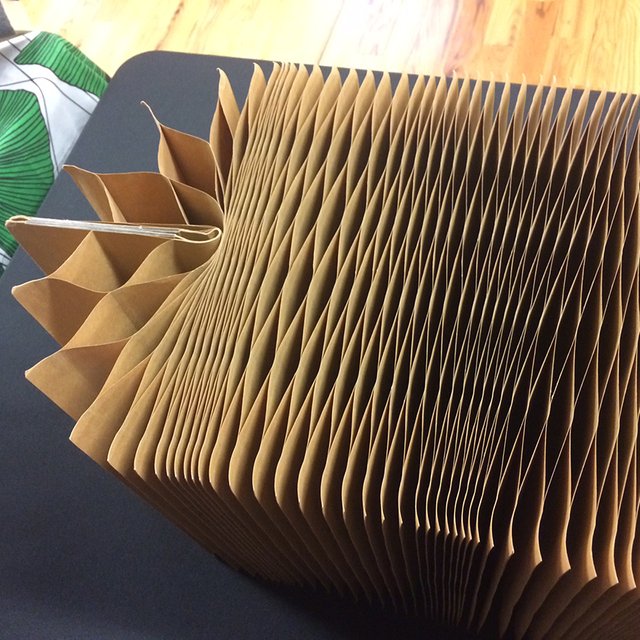 You can see this paper shelf in the first display picture in this post if you look carefully. I was able to spread it across both 6' tables and use it to display a number of pieces.
You can see this paper shelf in the first display picture in this post if you look carefully. I was able to spread it across both 6' tables and use it to display a number of pieces.
Tabletop Containers and Art Print Display
I currently keep my display to little wooden boxes (bought at Target in the kids’ art section) and picture display easels purchased at a local craft store. I’ve also been known to find boxes, bins, and containers and spray paint them in a selection of colors.
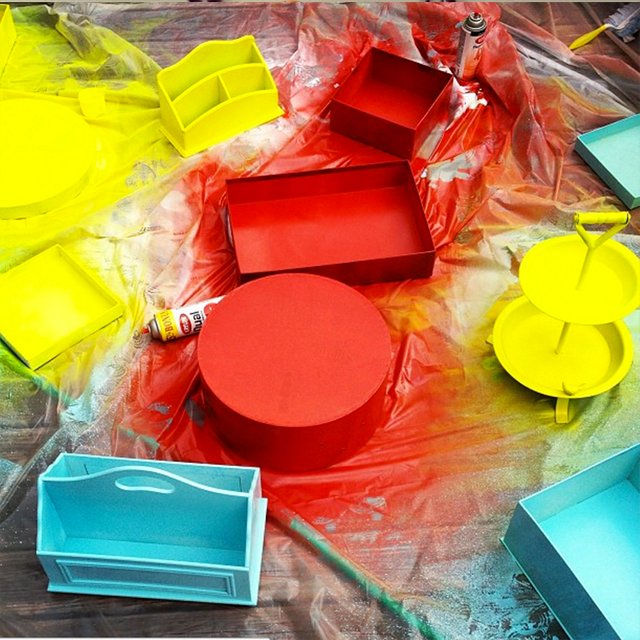
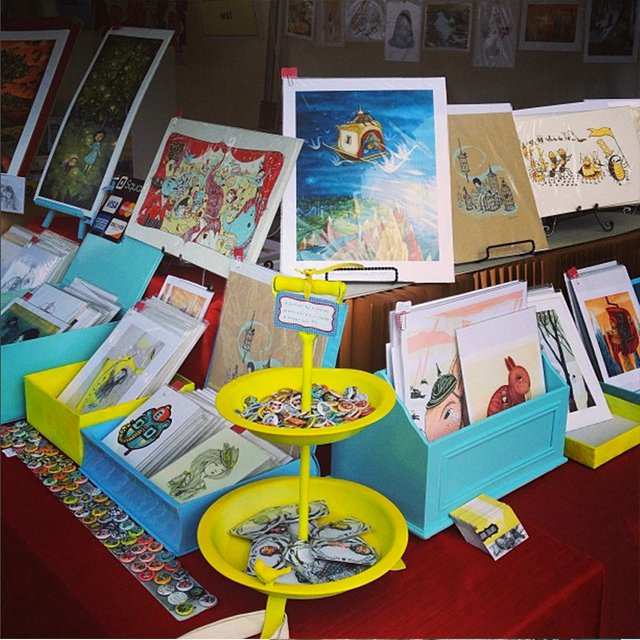
Warehouse stores like Costco often have all kinds of good boxes for displays that can simply be painted! This is a very cheap solution and can make your booth stand out and brand your products on the cheap.
You can also buy print racks to easily file larger works that won't fit in bins or boxes.
Signage and Branding
Every booth needs a sign so that people can find you and get a sense of what you do. I designed this one using one of my own patterns and bright colors that match some of my promotional material and express a playful tone.
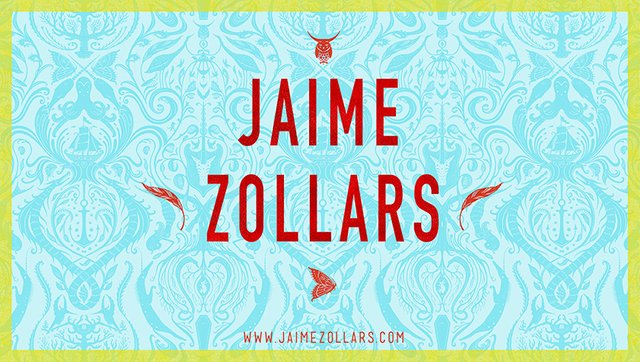
This sign is three feet long and cost only about $20 online on sale, including the shipping! I purchased it via Vistaprint, but there are many other companies that print vinyl signs in sizes big and small.
Your business cards should reflect your artwork as well. Choose a color or a symbol and carry it through your promotional materials and display. Business cards are very important to have on hand for shows. It makes sense to buy these in large quantities at cheap rates if you plan to do multiple shows. I get my business cards at Overnight Prints to set out at shows for people to pick up. Festivals are not the place to bring your most expensive promotional materials because so many will be taken (and many will be tossed).
Buy tablecloths in your signature colors. Patterns are okay if you keep the rest of your display simple! Match the display to your product in a seamless way. If you sell natural candles, you may want to use natural materials in your display and naturally dyed cloth for your table. Your display can absolutely stand out for being quiet and authentic and true to your brand, so don’t feel you have to compete by choosing a circus of color. My bright yellow spray paint is not for everyone and certainly not for all products!
Pinterest is a great place for searching “craft show display ideas” or “art booth ideas”. You will find way more ideas by exploring the displays of experienced artists and craftspeople. If you have a product line and wish to brand it (and have the money to hire help), the folks at Aeolidia are very good at branding and merchandising small businesses.
Onsite Additions
If you are a 2D artist selling prints, bring clothespins and clothesline (or similar clips and rope). You may find that there is a wall behind you (or you can buy a wall for your tent to close it off) and you might be able to tie rope across the back and display more prints. The more different images you can display (without the booth becoming messy and overwhelming) the better. Sales occur when the right person see the right piece. You increase those odds with every piece you are able to display.
Thanks for reading Part Three: Preparing Your Display.
If your missed Part One: Finding Shows and Getting In, you can read it here.
If you missed Part Two: Preparing Your Work, you can read it here.
Now you should have a basic understanding of show applications, preparing your work to sell, and creating a display. And with that, the big day is finally upon us! In Part Four: Getting Sales you will learn about show day and making the sale without having to sell yourself. You’ll also learn what you need to bring with you on the day of the event. Expect that post soon. If you have questions to ask or advice to add on this topic, please do reply and comment for the benefit of all!
Images © Jaime Zollars
This post has been linked to from another place on Steem.
Learn more about linkback bot v0.4. Upvote if you want the bot to continue posting linkbacks for your posts. Flag if otherwise.
Built by @ontofractal
Downvoting a post can decrease pending rewards and make it less visible. Common reasons:
Submit
Very cool - practical and inspired action at the same time!
Downvoting a post can decrease pending rewards and make it less visible. Common reasons:
Submit
Thank you! I try to be practical and share all I know!
Downvoting a post can decrease pending rewards and make it less visible. Common reasons:
Submit
Just discovered your article series, very well done! My interest is more in the arena of comic & pop culture conventions but there's a lot of relevant stuff here. I appreciate the links and info on your booth display materials and techniques.
Downvoting a post can decrease pending rewards and make it less visible. Common reasons:
Submit
Thanks! Yes, much of this will work for comic conventions too! Los of my friends participate in those!
Downvoting a post can decrease pending rewards and make it less visible. Common reasons:
Submit
Great info, thanks !
Downvoting a post can decrease pending rewards and make it less visible. Common reasons:
Submit
thanks @natureofbeing!
Downvoting a post can decrease pending rewards and make it less visible. Common reasons:
Submit
This is really good stuff -- so informative, descriptive. You should wrap this up in a pretty little book (with some of your fab artwork) and pop it up on amazon, when the series is finished. "Make Money With Your Art... Festivals and Fairs -- THE RIGHT WAY!"
Downvoting a post can decrease pending rewards and make it less visible. Common reasons:
Submit
ah, yes, good idea @macksby ! I clearly need a business consultant ;)
Downvoting a post can decrease pending rewards and make it less visible. Common reasons:
Submit
Looks like a professional art business person. Keep it up.
Up voted. The first time seeing your content. Followed
See my content about being involved in art for 10 years in Hawaii.
Downvoting a post can decrease pending rewards and make it less visible. Common reasons:
Submit
will do! thanks @hanamana !
Downvoting a post can decrease pending rewards and make it less visible. Common reasons:
Submit
Leaving a comment on this - I thought I had. A paper shelf! That is genius. I love how you prepare everything to look just right together. Thanks again for sharing your secrets.
Downvoting a post can decrease pending rewards and make it less visible. Common reasons:
Submit